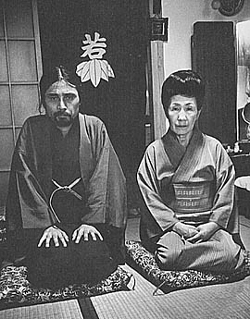Tatsumi Hijikata facts for kids
Quick facts for kids
Tatsumi Hijikata
|
|
|---|---|
| 土方 巽 | |

Tatsumi Hijikata (left) and Sada Abe (right) in 1969.
|
|
| Born | March 9, 1928 |
| Died | January 21, 1986 (aged 57) |
| Known for | Inventor of Butoh |
| Movement | Butoh |
Tatsumi Hijikata (土方 巽, Hijikata Tatsumi, March 9, 1928 – January 21, 1986) was a Japanese choreographer. He was the founder of a special kind of dance called Butoh. By the late 1960s, he had created this dance style. It uses very specific movements inspired by his childhood memories from northern Japan. This unique style is what many people think of when they hear about Butoh.
Contents
Life and the Creation of Butoh
Tatsumi Hijikata was born Kunio Yoneyama on March 9, 1928. He was born in Akita prefecture in northern Japan. He was the tenth of eleven children in his family. After moving between Tokyo and his hometown for a few years, he settled in Tokyo in 1952.
Early Dance Studies
In Tokyo, Hijikata studied many dance styles. These included tap, jazz, flamenco, ballet, and German expressionist dance. In 1959, he performed his first Ankoku Butoh piece, called Kinjiki. Around this time, he met three important people: Yukio Mishima, Eikoh Hosoe, and Donald Richie. They would help him with his future work.
Establishing Asbestos Hall
In 1962, Hijikata and his partner Motofuji Akiko opened a dance studio. It was called Asbestos Hall and was in the Meguro district of Tokyo. This studio became the main place for his dance work for the rest of his life. Many young dancers joined him there over the years.
Developing the Butoh Style
Hijikata saw Ankoku Butoh as a new and different type of dance art. He wanted it to be unlike any other Japanese dance forms. He wrote about his new dance style, calling it a dance of extreme body movements and changes. It explored deep feelings and questioned society at the time.
Influences and Collaborations
Many of his early works were inspired by European writers and artists. These included the French Surrealist movement. Surrealism had a big impact on Japanese art and literature. A Japanese poet named Shuzo Takiguchi saw Ankoku Butoh as a unique "Surrealist" dance.
From the late 1950s through the 1960s, Hijikata worked with many artists. He collaborated with filmmakers, photographers, and visual artists. One special project was with the Japanese photographer Eikoh Hosoe. They created a book called Kamaitachi. This book involved trips back to northern Japan. It showed Hijikata acting out mythical figures in the countryside. The book refers to stories of a supernatural being called a "sickle-weasel." In the photos, Hijikata is seen walking through the landscape and meeting farmers and children.
Later Years and Legacy
Hijikata performed and choreographed publicly from 1959 to 1972. His famous solo work, Hijikata Tatsumi and Japanese People: Revolt of the Body, was in 1968. He also performed in group dances like Twenty-seven Nights for Four Seasons in 1972. From the late 1960s to 1976, Hijikata used surreal images to change movements in his dances.
Withdrawal and New Focus
After 1976, Hijikata slowly stopped performing in public. He spent his time at Asbestos Hall writing and training his dance company. His work was often seen as very different and not fitting with traditional Japanese art. However, Hijikata felt his work was beyond the usual art movements. He once said, "I've never thought of myself as avant-garde. If you run around a race-track and are a full circuit behind everyone else, then you are alone and appear to be first. Maybe that is what happened to me..."
During his time away from public performances, Hijikata connected his Butoh ideas with his childhood memories. This led to a book called Ailing Dancer (1983). He also made scrapbooks with art images and his thoughts on dance.
Return to Choreography and Passing
By the mid-1980s, Hijikata began to choreograph again. He created work for the dancer Kazuo Ohno, with whom he had worked since the early 1960s. Ohno's work helped make Butoh famous worldwide. Hijikata planned to perform publicly again and started new projects. However, he passed away suddenly in January 1986, at age 57.
Asbestos Hall was later sold and became a private house. But Hijikata's film works, scrapbooks, and other items were saved. They are now part of an archive at Keio University in Tokyo. Tatsumi Hijikata continues to inspire artists around the world. This includes choreographers, performers, visual artists, filmmakers, writers, musicians, and architects.
The Beginnings of Butoh
The very first Butoh dance piece was called Kinjiki (Forbidden Colours). Tatsumi Hijikata performed it at a dance festival in 1959. It was based on a novel of the same name by Yukio Mishima.
Naming the Dance
At first, the earliest Butoh performances were called "Dance Experience" in English. In the early 1960s, Hijikata used the term "Ankoku-Buyou" (暗黒舞踊). This means "dance of darkness." Later, he changed the word "buyo" to "butoh." "Buyo" was linked to classical Japanese dance. "Butoh" was an old word for dance that originally meant European ballroom dancing.
Butoh's Unique Language
In his later work, Hijikata kept challenging traditional ideas of dance. He was inspired by writers like Yukio Mishima and others. He explored themes of the unusual and transformation. Hijikata also looked at how the human body could change into other forms, like animals. He created a special, poetic language for his choreography called butoh-fu. The word "fu" means "word" in Japanese. This language helped dancers change into different states of being.
See also
 In Spanish: Tatsumi Hijikata para niños
In Spanish: Tatsumi Hijikata para niños
- List of dancers

